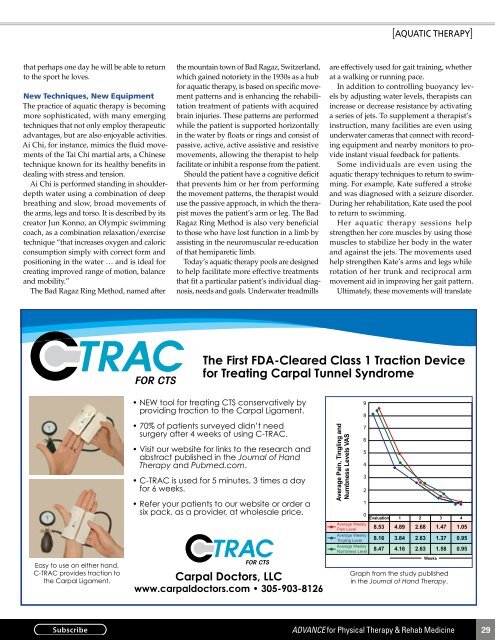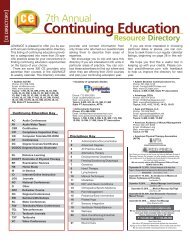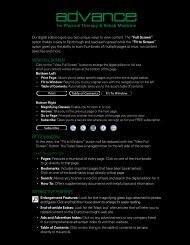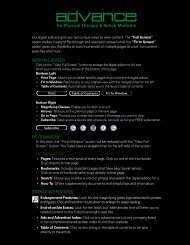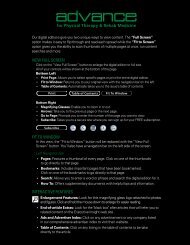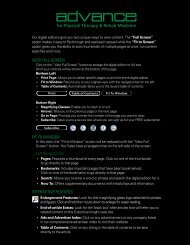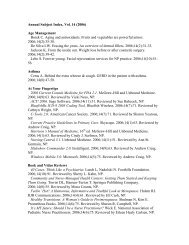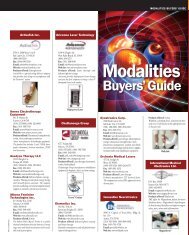Download - ADVANCE for Physical Therapy & Rehab Medicine
Download - ADVANCE for Physical Therapy & Rehab Medicine
Download - ADVANCE for Physical Therapy & Rehab Medicine
Create successful ePaper yourself
Turn your PDF publications into a flip-book with our unique Google optimized e-Paper software.
that perhaps one day he will be able to return<br />
to the sport he loves.<br />
New Techniques, New Equipment<br />
The practice of aquatic therapy is becoming<br />
more sophisticated, with many emerging<br />
techniques that not only employ therapeutic<br />
advantages, but are also enjoyable activities.<br />
Ai Chi, <strong>for</strong> instance, mimics the fluid movements<br />
of the Tai Chi martial arts, a Chinese<br />
technique known <strong>for</strong> its healthy benefits in<br />
dealing with stress and tension.<br />
Ai Chi is per<strong>for</strong>med standing in shoulderdepth<br />
water using a combination of deep<br />
breathing and slow, broad movements of<br />
the arms, legs and torso. It is described by its<br />
creator Jun Konno, an Olympic swimming<br />
coach, as a combination relaxation/exercise<br />
technique “that increases oxygen and caloric<br />
consumption simply with correct <strong>for</strong>m and<br />
positioning in the water … and is ideal <strong>for</strong><br />
creating improved range of motion, balance<br />
and mobility.”<br />
The Bad Ragaz Ring Method, named after<br />
Easy to use on either hand,<br />
C-TRAC provides traction to<br />
the Carpal Ligament.<br />
the mountain town of Bad Ragaz, Switzerland,<br />
which gained notoriety in the 1930s as a hub<br />
<strong>for</strong> aquatic therapy, is based on specific movement<br />
patterns and is enhancing the rehabilitation<br />
treatment of patients with acquired<br />
brain injuries. These patterns are per<strong>for</strong>med<br />
while the patient is supported horizontally<br />
in the water by floats or rings and consist of<br />
passive, active, active assistive and resistive<br />
movements, allowing the therapist to help<br />
facilitate or inhibit a response from the patient.<br />
Should the patient have a cognitive deficit<br />
that prevents him or her from per<strong>for</strong>ming<br />
the movement patterns, the therapist would<br />
use the passive approach, in which the therapist<br />
moves the patient’s arm or leg. The Bad<br />
Ragaz Ring Method is also very beneficial<br />
to those who have lost function in a limb by<br />
assisting in the neuromuscular re-education<br />
of that hemiparetic limb.<br />
Today’s aquatic therapy pools are designed<br />
to help facilitate more effective treatments<br />
that fit a particular patient’s individual diagnosis,<br />
needs and goals. Underwater treadmills<br />
[AquAtIC tHERAPY]<br />
are effectively used <strong>for</strong> gait training, whether<br />
at a walking or running pace.<br />
In addition to controlling buoyancy levels<br />
by adjusting water levels, therapists can<br />
increase or decrease resistance by activating<br />
a series of jets. To supplement a therapist’s<br />
instruction, many facilities are even using<br />
underwater cameras that connect with recording<br />
equipment and nearby monitors to provide<br />
instant visual feedback <strong>for</strong> patients.<br />
Some individuals are even using the<br />
aquatic therapy techniques to return to swimming.<br />
For example, Kate suffered a stroke<br />
and was diagnosed with a seizure disorder.<br />
During her rehabilitation, Kate used the pool<br />
to return to swimming.<br />
Her aquatic therapy sessions help<br />
strengthen her core muscles by using those<br />
muscles to stabilize her body in the water<br />
and against the jets. The movements used<br />
help strengthen Kate’s arms and legs while<br />
rotation of her trunk and reciprocal arm<br />
movement aid in improving her gait pattern.<br />
Ultimately, these movements will translate<br />
The First FDA-Cleared Class 1 Traction Device<br />
<strong>for</strong> Treating Carpal Tunnel Syndrome<br />
• NEW tool <strong>for</strong> treating CTS conservatively by<br />
providing traction to the Carpal Ligament.<br />
• 70% of patients surveyed didn’t need<br />
surgery after 4 weeks of using C-TRAC.<br />
• Visit our website <strong>for</strong> links to the research and<br />
abstract published in the Journal of Hand<br />
<strong>Therapy</strong> and Pubmed.com.<br />
• C-TRAC is used <strong>for</strong> 5 minutes, 3 times a day<br />
<strong>for</strong> 6 weeks.<br />
• Refer your patients to our website or order a<br />
six pack, as a provider, at wholesale price.<br />
Carpal Doctors, LLC<br />
www.carpaldoctors.com • 305-903-8126<br />
Average Pain, Tingling and<br />
Numbness Levels VAS<br />
9<br />
8<br />
7<br />
6<br />
5<br />
4<br />
3<br />
2<br />
1<br />
0 Evaluation 1 2 3 4<br />
Average Weekly<br />
Pain Level 8.53 4.89 2.68 1.47 1.05<br />
Average Weekly<br />
Tingling Level 8.16 3.84 2.63 1.37 0.95<br />
Average Weekly<br />
Numbness Level 8.47 4.16 2.63 1.58 0.95<br />
Weeks<br />
Graph from the study published<br />
in the Journal of Hand <strong>Therapy</strong>.<br />
<strong>ADVANCE</strong> <strong>for</strong> <strong>Physical</strong> <strong>Therapy</strong> & <strong>Rehab</strong> <strong>Medicine</strong><br />
29


